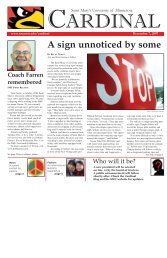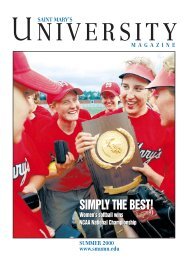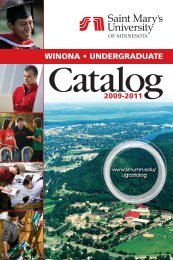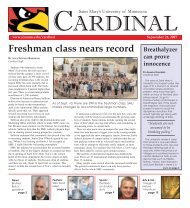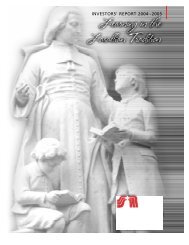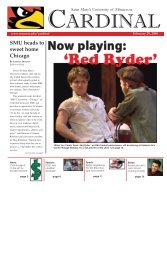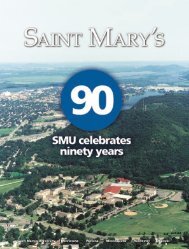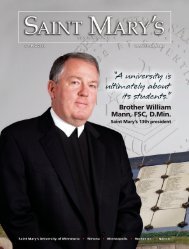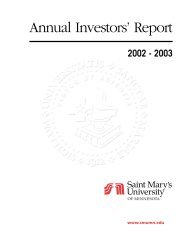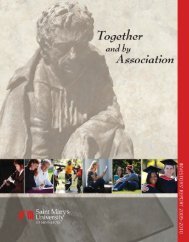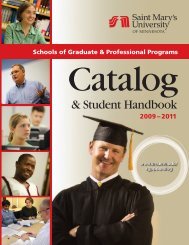PDF version - Saint Mary's University of Minnesota
PDF version - Saint Mary's University of Minnesota
PDF version - Saint Mary's University of Minnesota
You also want an ePaper? Increase the reach of your titles
YUMPU automatically turns print PDFs into web optimized ePapers that Google loves.
Academic Policies and Procedures<br />
Academic Probation<br />
A full-time student is placed on academic probation if the cumulative GPA is:<br />
1. below 1.600 at end <strong>of</strong> first semester;<br />
2. below 1.750 at end <strong>of</strong> second semester;<br />
3. below 1.900 at end <strong>of</strong> third semester; or<br />
4. below 2.000 at end <strong>of</strong> any subsequent semester.<br />
Students must improve their GPA in the following semester to above the probation level or face possible<br />
dismissal.<br />
Academic Dismissal<br />
A student enrolled full-time at the beginning <strong>of</strong> the semester is dismissed for low scholarship upon<br />
failure in any semester to earn six credits, if the GPA is less than 1.000 in any given semester, or if the<br />
cumulative GPA is at a probationary level for a second consecutive semester.<br />
Program for Academic Success (PASS) students are required to earn a minimum 2.000 cumulative GPA by<br />
the end <strong>of</strong> their first academic year. PASS students who do not earn a cumulative 2.000 GPA will be dismissed.<br />
A student enrolled part-time at the beginning <strong>of</strong> the semester is dismissed for low scholarship if the<br />
semester GPA is less than 1.000 in any given semester and the cumulative GPA is less than 2.000.<br />
Dismissed students who are allowed to remain or be re-admitted to the College shall be placed on<br />
monitored probation.<br />
Appeal for Academic Reinstatement<br />
A student who has been dismissed for low scholarship may appeal for reinstatement in person to the<br />
academic standing committee after one semester has lapsed. A student who is a second-semester<br />
senior may appeal immediately. If the committee recommends to the <strong>of</strong>fice <strong>of</strong> the vice president for<br />
academic affairs that readmission is appropriate and the vice president agrees, the student will be<br />
placed on monitored probation, wherein the student must sign a contract which specifies restrictions,<br />
requirements, and minimum academic achievement. It should be emphasized that a student on<br />
probation may have to conform to more rigid requirements than the general student body. Students<br />
who are reinstated must also complete the application process through the admission <strong>of</strong>fice.<br />
Disruptive Behavior<br />
Classrooms and laboratories are important venues where <strong>Saint</strong> Mary’s <strong>University</strong> <strong>of</strong> <strong>Minnesota</strong> carries<br />
out its mission <strong>of</strong> teaching and learning; every participant in the learning community contributes to<br />
this. The faculty are pr<strong>of</strong>essionally trained in and institutionally accountable for maintaining a safe and<br />
productive classroom environment that facilitates study, clarity <strong>of</strong> thought, focused attention, and<br />
fruitful dialogue in an atmosphere free from distraction and disorder. Discourteous, disrespectful, or<br />
disruptive student behavior is not tolerated. Examples <strong>of</strong> such behavior include but are not limited to:<br />
• Speaking while the instructor or another person is talking;<br />
• Words or gestures openly dismissive or contemptuous <strong>of</strong> another student’s or the instructor’s opinion<br />
or contributions;<br />
• Repeated questions or interruptions which interfere with an instructor’s or another student’s presentation;<br />
• Overt inattentiveness (e.g., sleeping in class; loud yawning or other gestures indicative <strong>of</strong> disengagement<br />
or boredom; reading the newspaper or other non-class material during class activities or presentations);<br />
• Texting, reading or sending e-mails, or other use <strong>of</strong> a cell phone or pager in class;<br />
• Refusal to comply with classroom instructions or laboratory safety protocols;<br />
• Inappropriate or unwelcome words or gestures <strong>of</strong> physical affection.<br />
28



